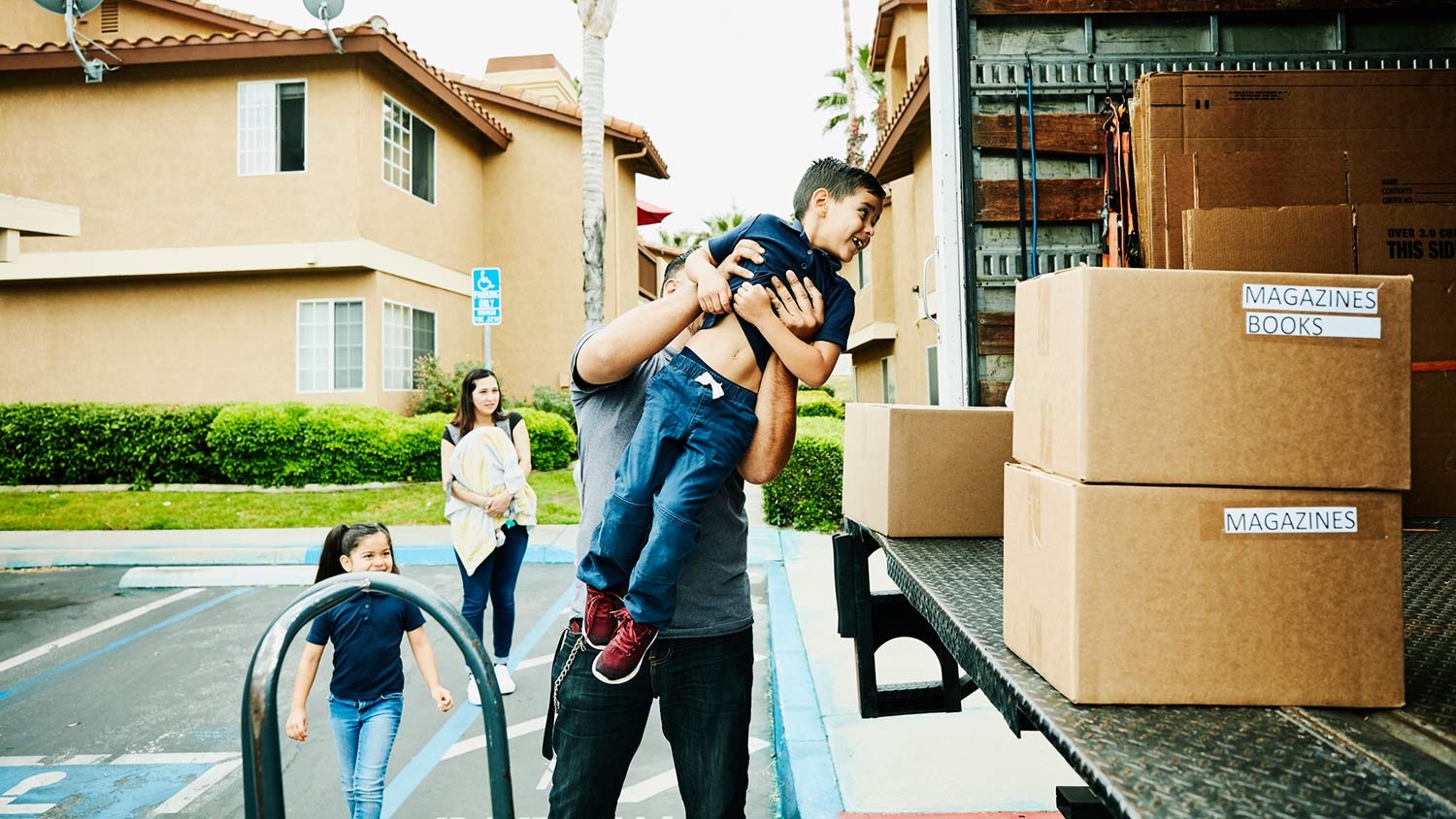Moving During COVID-19: Reasons, Risks, and Rewards
Masking up, packing up, moving on up: here’s what it was like to change homes during the COVID-19 pandemic


While many of us have spent more time in our homes during the pandemic than ever before, for some people, it’s proven the right time to find a new one. Even at the height of the lockdowns and social distancing measures that followed the appearance of COVID-19, buying, selling, and moving houses never stopped. Homeowners who moved in these unprecedented circumstances faced unique challenges—but also rewards. Learn more about buyers’ experiences moving amid a global pandemic.
The Need for More Space was the No. 1 Factor for Pandemic Movers
No matter how much space you were working with before the pandemic began, lockdown, a loss of privacy, and more limited time away from home likely left you feeling cramped (and despite our best efforts, all those Zoom parties didn’t help much). It’s not a huge surprise, then, that 45% of respondents cited a need for more space as one reason behind their move. Nearly as many (41%) shared that the additional flexibility granted by working from home influenced their decision.
Space and working-from-home needs were cited with particular frequency among homeowners in the Northeast, while their share was split more evenly with other factors in responses from the Midwest, South, and West. Outside the top two reasons, people claim to have moved because:
34% desired to be closer to family
40% said their previous home could not accommodate changes to their lifestyle
35% pointed to career changes that necessitated a move
33% said they moved to get a better deal than their previous rent or mortgage
37% cited the desire to move to a less densely populated area
The Need for Space Translated to Purchasing Larger Houses
Nearly half of the respondents (49.9%) moved from a single-family home—with 24.7% leaving large (4 or more bedroom) homes and 25.2% leaving small (1 to 3 bedroom) homes. Among the rest, 11% moved from a townhome, 11% from a condo, 13% from a multi-family home, and 15% from a rental.
The highest number of respondents, 31%, moved into a large single-family home—amounting to a more than 25% increase for the category. Townhomes also saw a boost in popularity, accounting for 16% of respondents’ new homes, a 46% increase.
More than four out of five respondents had already been planning to move before the pandemic remade our lives. 35% said COVID-19 caused them to speed up the process, 29% said it slowed them down, and 23% reported it caused no change to their schedule.
...But Not a Decline In Urban Living

The first waves of the COVID-19 pandemic struck major cities like New York particularly hard, and lockdown and quarantine conditions proved especially trying for those in small apartments without outdoor spaces, leading many to predict a surge of city dwellers fleeing for the suburbs and the quiet of the countryside. Our survey results suggest that these predictions aren’t actually panning out.
While 65% of survey participants moved outside of their metropolitan area—37% within the same region, and 28% longer distances—overall urban living among our sample did not decline, but in fact, saw a slight uptick. While 42% of respondents lived in an urban location pre-move, 44% did afterward.
Among respondents who started the pandemic in an urban environment, 30% relocated their primary residence to the suburbs or a rural area. Still, these numbers are dwarfed by the majority of rural respondents who packed up and left for denser climes, with 27% of movers relocating to cities and 30% heading to the suburbs.
The Majority Hired Professional Movers...
Under any circumstances, moving houses without professional help can be a punishing task for all but the most rugged. So it’s not a huge surprise that, facing the added stresses of the pandemic, the majority of survey participants (65%) hired professional movers—with 41% opting for full service, and 24% for partial help. Among the rest, 21% relied on family and friends (hopefully with the help of a few pizzas, too), and 14% did it alone.
More than half of those who opted to rely on pros pointed to three main reasons: ensuring their belongings made the voyage in tiptop shape, and saving time and avoiding the hassle.
Of those who hired movers:
49% said the experience was better than expected, while only 25% said it was worse
48% said they ended up paying more than anticipated, while 23% say they spent less
91% faced at least one major issue during their move
Almost half of respondents (48%) said the move took longer than expected
All in all, better than one might expect in the midst of a world-historic global health crisis!
...While Some Rolled Up Their Sleeves

Those who relied on Uncle Joe and his old Toyota truck couldn’t avoid the unique complexities presented by the pandemic, either. Among respondents who did not hire movers, the most common reasons were saving money and access to help from friends and family. 84% of them said they encountered at least one major issue during their move.
When asked about the issues they encountered that were made worse by the pandemic, 30% said they ran into unexpected difficulties in renting a moving truck, and 29% said that the process took longer than anticipated.
40% of respondents said they declined hiring movers because they had enough friends and family able to help.
Most Pandemic Movers Conducted Professional Inspections...
While purchasing a home in the U.S. has become increasingly competitive, a larger proportion of buyers have been waiving inspections than in previous years (according to data from Redfin, for example, 20% of winning buyers declined an inspection in June 2020, a 13% increase from the previous year), but they remain a small minority nevertheless. 75% of respondents had an official inspection performed before closing on their homes, with inspectors noting concerns in 93% of these cases. Those who commissioned inspections received reports noting issues in a variety of different areas:
Plumbing: 41%
Electricity: 39%
Roofing: 38%
Garage: 36%
Flooring: 36%
Water damage: 35%
Driveway/walkways: 34%
Landscaping: 33%
Foundation: 33%
Siding: 31%
Other: 9%
For the vast majority of buyers who opted for official inspections, the seller handled the issues noted in the report.
Among the 7% of buyers who got official reports noting problems but did not get sellers to take care of them, the most common reasons were that they had previously waived inspection items under a specific cost and that they declined to ask sellers to address concerns out of fear of losing their house.
The majority of buyers who received inspections noting problems in particular areas in the house reported that they had already addressed those concerns by the time of the survey. In every category of necessary repair, at least 71% of buyers hired professionals to resolve the issue rather than doing it themselves. Of repairs and renovations that buyers did perform DIY, landscaping and driveways/walkways were the most frequent areas, while electricity was (for good reason!) least frequently addressed without professional help.
...While Some Skipped the Inspection
Of the one in four respondents who did not commission an official inspection before moving in, 36% had one after moving in, and 29% were still planning to perform one.
Those who declined a pre-move inspection cited different reasons:
To move in more quickly: 35%
Confidence that there were no problems from personal viewing: 31%
Had funds saved for a worst-case scenario: 25%
To speed up closing: 24%
To avoid being outbid: 21%
Other: 18%
Asked if they would recommend waiving inspection, 16% of respondents who waived inspection said they would if doing so gets you the home you want, 44% say it depends on the house, and 21% said they would not recommend it after the problems faced. 20% of inspection waivers noted that the decision was a mistake they would urge others not to make.
With or Without Inspection, Nearly All Pandemic Movers Faced Surprises and Unexpected Costs

While a lucky 19% of respondents said they moved into a perfect house, 81% affirmed that they discovered problems with their house after moving in. 42% said that these included “major” issues. Cosmetic issues were the most common, cited by 40% of participants.
An even more significant proportion of respondents—89%—said they shouldered unanticipated costs after moving in. These unexpected expenses stemmed from:
Necessary repairs or renovations: 38%
Appliance repairs or replacements: 37%
Cosmetic improvements: 36%
Utility bills: 35%
Security system: 34%
Insurance premiums: 32%
Structural damage: 31%
Other: 11%
Plumbing was also cited more frequently than other areas—by 15% of respondents—when participants shared the part of their home responsible for the most surprise problems and disappointments.
Respondents also shared the features they were surprised to find missing or lacking in their new homes:
Air conditioning or heating: 36%
Effective faucets, hot water, or water pressure: 35%
Weatherproofed deck, siding, or roofing: 34%
Electrical outlets: 32%
Light fixtures or light switches: 31%
Shades or window treatments: 31%
Closets: 26%
What They Wish They Had Known
Even the most knowledgeable or insightful home buyer could not have anticipated the extraordinary consequences of a global pandemic. Those who moved their primary residence after March 2020 had to improvise and learn on the fly what they could do to navigate confusing and constantly changing conditions. Luckily, those buying or considering buying now can learn a lot from their experiences (and now, share their knowledge with others!).
The median range of unexpected expenses foisted on respondents fell between $2,000 and $3,000, with 25% reporting spending more than $4,000.
When asked what, in retrospect, they wished they had known before moving during the pandemic, more than one-third of respondents cited the following factors:
Planning further in advance
Doing more research
Reading reviews of professional movers
Hiring movers
Negotiating more with the seller
Asked to specify the one thing they could tell themselves to improve the experience, the largest number of respondents (17%) said they would do a home inspection, followed closely by hiring movers, anticipating higher expenses, and asking more questions.
Pandemic Movers Are Ready to Renovate
Across the board, most pandemic movers said their home still needs renovations, with 48% saying it needs minor work and 30% saying they expect to undertake significant changes. Likewise, the majority of participants expressed a desire to undertake major home improvement projects, such as solar installation and yard drought proofing.
Respondents identified outdoor landscaping (15%) and the living room (15%) as their top priorities.
Will They Stay or Will They Go?
After a whirlwind move, pandemic buyers are now contemplating a variety of different future paths. While a plurality of respondents (at 46%) said they had little-to-no desire to sell their current home, 31% said they were seriously exploring the possibility or already in the process of selling.
Methodology
The survey, conducted by DKC Analytics on behalf of Angi, posed 42 questions to a sample of 1,000 US homeowners who changed their primary residence between March 2020 and September 2021. No weighting has been applied to the sample. The responses were solicited and analyzed using the Pollfish survey delivery platform.

(Photos By boonchai wedmakawand/Moment via Getty Images; MoMo Productions/DigitalVision via Getty Images; sturti/E+ via Getty Images; -VICTOR-/DigitalVision Vectors via Getty Images; -VICTOR-/DigitalVision Vectors via Getty Images; nezezon2/iStock/Getty Images Plus via Getty Images; Ridofranz/iStock/Getty Images Plus via Getty Images. From top to bottom.)





- Angi's Moving Survey Sheds Light on Trends and Mover Satisfaction
- This Is What Homeowners Say Is Most Unrealistic About Home Improvement TV Shows
- The Risks and Rewards of DIY Home Improvement
- Study: 94% of Americans Care About How Their Lawn Looks, But Are They Maintaining It Correctly?
- Survey: Should I Sell My House Now? 74% Are Hesitant
- Are You Supposed to Help Movers? 12 Things To Do While Movers Work
- A First-Time Homeowners' Guide to Repairs
- 10 Most Expensive States to Maintain a Home [Survey]
- Keep Calm and Renovate On: Keep Home Projects Stress-Free
- Christmas Decor Trends 2024: What Are the Most Popular Decorations in America?









